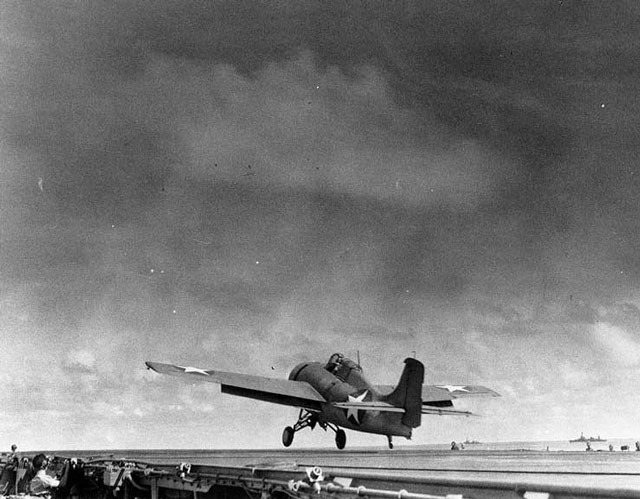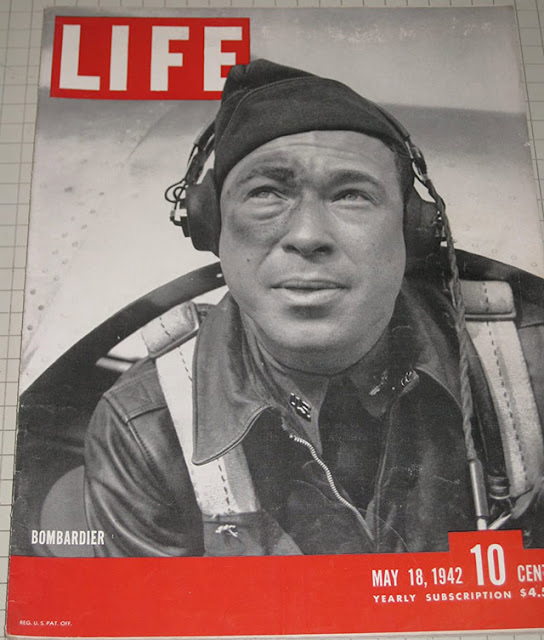Monday 18 May 1942
Battle of the Pacific: While still awaiting definitive proof as to the next Japanese target, which has the codename AF, the three major US naval intelligence centers in Washington, Honolulu, and Melbourne on 18 May 1942 report that an attack will happen soon from AF's northwest. The Melbourne station (formerly based at Corregidor and considered the least "political" of the stations) adds that the airstrikes will take place from 50 miles northwest of AF.
Admiral Nimitz, trusting in an unproven hunch by some of his intelligence officers that AF refers to Midway, orders submarines to patrol fifty miles northwest of the island. He also orders US Navy Task Forces 16 and 17 to leave the Efate area and head east toward Pearl Harbor. This leaves no US aircraft carriers in the southwest Pacific, but Nimitz is confident that the Japanese won't stir up trouble there due to his recent ruse. The Japanese recently sighted USS Enterprise and Yorktown as Nimitz intended and don't know where they are heading. This sighting has convinced the Japanese to suspend all offensive operations in the area, completing Nimitz's successful gamesmanship.
B-17 bombers attack the airfield at Koepang, Timor.
 |
| Admiral Nimitz is on the cover of Time magazine, 18 May 1942. |
Battle of the Indian Ocean: Japanese troops occupy Pantha on the Chindwin River. More British and Indian troops of BURCORPS straggle into Indian and Burmese border towns such as Tamu and Imphal. the final unit of the 17th Indian Infantry Division, the rearguard 63rd Indian Infantry Brigade, arrives in Tamu. The entire division has 9,908 men and now is sent up to Imphal to reform with the 48th and 16th Indian Infantry Brigades.
 |
| The 18 May 1942 Daily Mirror is full of news about German problems at Kharkov. |
Eastern Front: In the early morning hours, General Ivan Bagramyan, chief of staff to Marshal Timoshenko at Southwestern Front, comes out openly against the continuation of the Red Army offensive in light of the fierce German counterattacks. He points to successful German advances in the Barvenkovo region and suggests moving troops there. Timoshenko disagrees and visits Stalin later in the morning, telling him that everything is fine and the offensive can continue heading west. Bagramyan appeals to political Commissar Nikita Khruschhev to appeal to Stalin. Khruschev also is having his doubts and calls Marshal Vasilevskiy of the Stavka to ask Stalin to change his mind (despite being the highest-ranking soldier in the USSR, Vasilevskiy's main job was to screen Stalin's phone calls). At this point, the primary sources contradict themselves as to who exactly speaks to whom about what, but the bottom line is that Stalin adamantly refuses to override Timoshenko. The Red Army keeps attacking 180 degrees away from the danger point.
On the German side, it is becoming clear that a major victory may be possible, but the whole affair remains a wild gamble. Field Marshal Fedor von Bock, commander of Army Group South, visits General Ewald von Kleist, commander of First Panzer Army, at Stalino to plan the next step. Both are mystified at the Soviet failure to respond to the developing mortal threat to the southern Red Army pincer arm. Bock is concerned because if the Soviets take Kharkov, he'll look bad to Hitler regardless of ultimate success. He and Kleist basically shrug and continue strengthening the push to cut the Soviets off at Izyum.
During the day, Timoshenko orders his tank forces to smash forward toward Kharkov from the south. At Fuhrer headquarters, General Franz Halder notes that "The number of tank brigades committed by the enemy is really astounding." They make temporary progress in some places, but the attacking units have been weakened by Timoshenko's removal of one tank corps to guard Izyum from the First Panzer Army counterattack (it has not yet arrived there). Local German counterattacks restore the front south of Kharkov by the end of the day.
 |
| Marder III tank destroyer (Sd. Kfz. 139) in Crimea, May 1942 (Federal Archive B 145 Fig. F016217-0015A). |
The Luftwaffe continues transferring units from Crimea and begins asserting itself all across the Kharkov front. It establishes complete aerial dominance. Fliegerkorps IV claims to destroy 130 tanks and 500 motor vehicles. German panzer troops of Seventeenth Army and III Panzer Corps continue barreling north at the Soviet breakout point and reach Izyum, narrowing the Soviet supply corridor to the Red Army troops advancing further west. The Soviet breakthrough point is now down to about a 20-mile breach, still sufficient and significant but showing no signs of withstanding the advancing panzers. The Soviets are not sending troops back east through the corridor to safety, the flow of traffic remains to the west.
Luftwaffe ace Gordon "Mac" Gollob continues his torrid streak in the air after taking over JG 77. Operating out of Kerch, Crimea, he claims three Polikarpov R-5 reconnaissance bombers for his 94th to 96 victories. He is eager to reach the 100-victory mark quickly, a matter of pride to Luftwaffe units. On the ground, General Manstein's 11th Army continues to whittle away at the few Red Army pockets left in the Kerch area. General Halder notes that "the few small remnants left are still fighting fiercely."
Today is considered the termination of the Demyansk supply operation by the Luftwaffe. It has been a successful mission, but aircraft losses total 265 planes, many of them Ju-52 transports The main supply unit, KGzbV 8, is disbanded and its planes returned to training schools.
 |
| A Grumman F4F Wildcat took off from the USS Enterprise's flight deck on May 18, 1942 (US Navy). |
European Air Operations: There are no major operations by either side along the Channel Front as a lengthy springtime lull continues.
 |
| General Stilwell's headquarters burns in Maymyo, Burma, in this photo from the 18 May 1942 Life magazine. |
Battle of the Atlantic: U-558 (Kptlt. Günther Krech), on its seventh patrol out of Brest, torpedoes and sinks 1254-ton Dutch freighter Fauna in the Caicos Passage near the Turks and Caicos Islands. There are two deaths and 27 survivors.
U-156 (Kptlt. Werner Hartenstein), on its third patrol out of Lorient, torpedoes and sinks 4961-ton US freighter Quaker City 300 nautical miles east of Barbados. The U-boat surfaces, questions the crewmen in their four lifeboats, and directs them to Barbados. There are 11 deaths and 29 survivors, who are mostly rescued by USS Blakeley.
U-125 (Kptlt. Ulrich Folkers), on its fourth patrol out of Lorient, sinks 8893-ton US tanker Mercury Sun 125 nautical miles (232 km) south of Cape Corrientes, Cuba. There are six deaths and 29 survivors, who are rescued by SS Howard.
U-125 also torpedoes and sinks 2616-ton US freighter William J. Salman 125 nautical miles (232 km) south of Cape Frances, Cuba. There are six deaths and 22 survivors, who are rescued by Latvian freighter Kegums.
Italian submarine Comandante Cappellini shells and sinks 5747-ton Swedish freighter Tisnaren midway between Brazil and Senegal. All 41 crewmen are rescued by US freighter Black Hawk.
Italian submarine Barbarigo torpedoes Brazilian freighter Commandante Lyra east of Fortaleza, Brazil. The damaged ship is towed to Fortaleza by seaplane tender USS Thrush (AVP-3).
The Luftwaffe raids shipping in the Kola Inlet. The score some near-misses on US freighter Deer Lodge, but the ship remains operational. It moves to another anchorage.
After over a month at sea, the last survivors of US freighter Alcoa Guide (sunk by U-123 on 16 April) are rescued by British freighter Hororata.
After almost a month at sea, a radio operator from US freighter Steel Maker, sunk by U-136 on 19 April, is found on a raft and rescued by an unnamed rescue raft. The man is in surprisingly good condition, having accumulated supplies from several rafts that floated free from the sinking ship.
US tanker Benjamin Brewster finds 19 survivors from US tanker Gulfoil, sunk by U-506 on 16 May.
 |
| Scientists J. Robert Oppenheimer takes over the US nuclear program on 18 May 1942. |
Battle of the Mediterranean: In Operation LB (part of "Club Run"), HMS Eagle ferries 17 Spitfire fighters to Malta. Malta now has 76 Spitfires operational. Six Albacores have issues and fail to fly off.
Royal Navy submarine HMS Turbulent sinks 2384-ton Italian freighter Bolsena off Benghazi. There are 50 deaths and 36 survivors.
Soldiers of the 1st Bn Dorsetshire Regiment on Malta capture an Italian spy at Marsascala Bay. The man, Giuseppe Guglielmo, who gives himself up willingly, admits to having been dropped off nearby by a naval torpedo boat. His mission was to investigate beach defenses. However, his pickup ride never arrived, so he surrendered.
Battle of the Black Sea: Soviet submarine ShCh-205 torpedoes and sinks 128-ton Turkish freighter Duatepe ten miles off the coast of Bulgaria. It also shells and sinks 350-ton Turkish schooner Kaynardzha in the same area.
Manhattan Project: Gregory Brett quits as the coordinator of physic research on fast neutron phenomena. Arthur H. Compton asks J. Robert Oppenheimer to replace him.
US/Panama Relations: The two countries sign an agreement providing for the use of Panamanian defense areas by US troops.
 |
| Life magazine of 18 May 1942 features an article about Bombardier school. |
US Military: Large numbers of US troops arrive in Northern Ireland on lighters after arriving in the Firth of Clyde aboard Queen Mary on 16 May. This is the fourth contingent of MAGNET Force. This completes the arrival of the 34th Infantry Division and includes most personnel from the 1st Armored Division. A separate group from the US Army 209th Coast Artillery (Antiaircraft) also arrives in Northern Ireland after alighting in Scotland on 17 May.
The Office of Naval Inspector General is established. Rear Admiral Charles P. Snyder is the first commander.
The US Army Air Force receives its first delivery of the Republic P-47B Thunderbolt. The plane will first see combat in April 1943.
 |
| A photo from an article about Bombardier School in Life magazine, 18 May 1942. |
British Military: Vice-Admiral Henry Harwood, a Lord Commissioner of the Admiralty and Assistant Chief of Naval Staff, becomes the Commander-in-Chief, Mediterranean Fleet. He flies his flag at HMS Nile.
Japanese Homefront: Hisao Yamazaki incorporates Daiwa Kogyo, Ltd. It is located in Suwa, Nagano Prefecture, Japan. Yamazaki is a local clock shop owner who is supported by the Hattori family (of Seiko Group fame), for whose company he used to work. Yamazaki's shop manufactures watch parts. In 1982, the entity, after various corporate transactions and after having evolved into a manufacturer of computer printers, renames itself the Epson Corporation.
American Homefront: The Santa Ana Register reports that 1,543 internees from Orange County, California, are now at "a concentration camp near Parker Dam, Arizona, as a result of expulsion of all persons of Japanese ancestry under Army Orders."
"Counterspy" starring Don MacLaughlin premieres on the NBC Blue Network (which became ABC). McLaughlin plays David Harding, chief of a secret US military unit named "Counterspies." Harding's organization combats the Gestapo and the Japanese Black Dragons during the war and various other organizations after 1945. The show is popular enough to remain on the radio until 29 November 1957 and spawns two feature films, but never airs on television.
 |
| Counterspy premieres on 18 May 1942. |


No comments:
Post a Comment